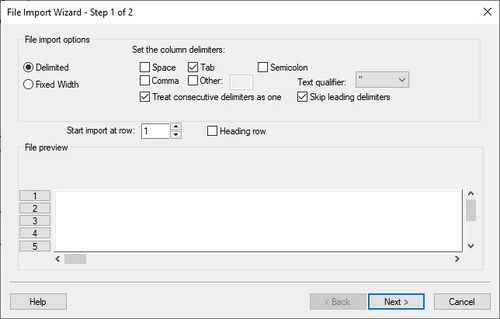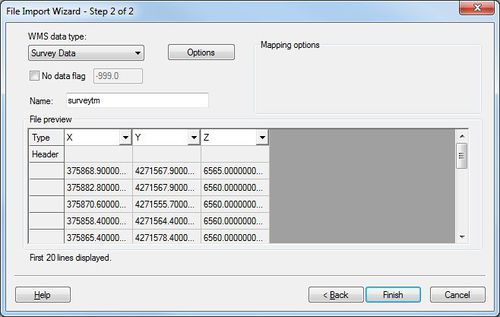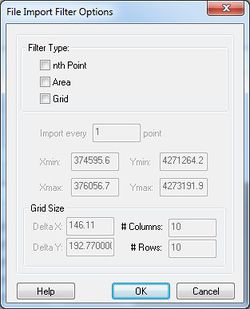WMS:File Import Wizard: Difference between revisions
No edit summary |
|||
| Line 2: | Line 2: | ||
WMS can read many files generated by other software in their native format. Refer to [[WMS:WMS Non-native Files|Non-native WMS Files]] for a list. For files that are not included in the list, WMS provides the ''File Import Wizard''. | WMS can read many files generated by other software in their native format. Refer to [[WMS:WMS Non-native Files|Non-native WMS Files]] for a list. For files that are not included in the list, WMS provides the ''File Import Wizard''. | ||
The ''File Import Wizard'' enables | The ''File Import Wizard'' enables importing many different types of data into WMS. The ''File Import Wizard'' is initialized by selecting a *.txt file in the '''Open''' command from the ''File'' menu, it can also be initiated by pasting data from a text file or spreadsheet into WMS using the [[WMS:Edit Menu#Paste|Paste]] command from the ''Edit'' menu. | ||
The wizard has two steps. | The wizard has two steps. | ||
Revision as of 16:23, 23 February 2016
WMS can read many files generated by other software in their native format. Refer to Non-native WMS Files for a list. For files that are not included in the list, WMS provides the File Import Wizard.
The File Import Wizard enables importing many different types of data into WMS. The File Import Wizard is initialized by selecting a *.txt file in the Open command from the File menu, it can also be initiated by pasting data from a text file or spreadsheet into WMS using the Paste command from the Edit menu.
The wizard has two steps.
Step 2 – Assigning Column Types
Step 1 – File Outline
The first step in the wizard allows delimiting the data into columns. Two options exist to delimit the data.
- Delimited
- Fixed Width
For the Delimited option, typical delimiters are included as well as an option to specify a delimiter. Columns can also be specified with a fixed width by clicking on the ruler bar or the window with the data. Break lines can be dragged, and they can be deleted by double-clicking on the break line or dragging them off the screen. Specify the starting row the data will be imported. If the data has a row of headings, indicate such and WMS will use the headings in the next step to determine what kind of data each column represents.
Step 2 – Assigning Column Types
The first 20 lines of the file are displayed in a spreadsheet according to the file outline specified in step 1. This step allows picking what kind of data to import (see the supported formats below). A "no data flag" can be specified for the file. This is a number that, when encountered in the file, tells WMS to mark the value as "NULL" or "no data". If the file type is a scatter point, the file can be marked as transient. If the file is transient, only one dataset can be created and all dataset columns become time steps of the dataset.
The data in the columns are identified by selecting the type in the combo box at the top of each column in the spreadsheet. If a row of headings exists, WMS will automatically select the proper type if it recognizes the heading. Otherwise they are labeled "Not Mapped" by default. The available column types changes depending on the WMS data type selected. Certain column types must be mapped for each file format before progressing to the next step in the wizard. The name of each column is changed by editing the Header cell.
File Import Filter Options
In Step 2 of the File Import Wizard dialog, when selecting "Survey Data", "TIN Vertices", or "Catalog" WMS data types an Options button becomes active. Selecting this button will bring up the File Import Filter Options dialog.
- Filter Type
- nth Point
- Area
- Grid
Supported Formats
The following types of data can be imported into WMS via the File Import Wizard:
Fields
A description of the fields (columns) that WMS recognizes when importing text files is provided in the tables below.
| 2D Scatter Points | |||
|---|---|---|---|
| Field | Type | Required | Comments |
| X | Number | yes | |
| Y | Number | yes | |
| Label | Text | no | |
| Material ID | Number | no | |
| Dataset | Number | no | One transient, or multiple steady state datasets. |
| Example | |||
| "id" "x" "y" "rain" "humidity" "OW-21" 32.4 5234.3 300 -999 "OW-22" 93.4 5832.3 84 398 "OW-23" 83.3 8438.2 89 47 | |||
Related Links
WMS – Watershed Modeling System | ||
|---|---|---|
| Modules: | Terrain Data • Drainage • Map • Hydrologic Modeling • River • GIS • 2D Grid • 2D Scatter |  |
| Models: | CE-QUAL-W2 • GSSHA • HEC-1 • HEC-HMS • HEC-RAS • HSPF • MODRAT • NSS • OC Hydrograph • OC Rational • Rational • River Tools • Storm Drain • SMPDBK • SWMM • TR-20 • TR-55 | |
| Toolbars: | Modules • Macros • Units • Digitize • Static Tools • Dynamic Tools • Drawing • Get Data Tools | |
| Aquaveo | ||


